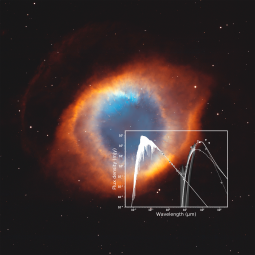by Jonathan Marshall & Joan Schmelz
Paper:
Evidence for the Disruption of a Planetary System During the Formation of the Helix Nebula
Marshall, Jonathan P., et al., 2023/01, AJ, 165, 22.
The survival of planetary systems after their host stars evolve off the main sequence is not well-constrained by observations. Many young white dwarf systems exhibit infrared excess emission and/or spectral absorption lines associated with a reservoir of dust or planetesimals. However, most white dwarfs are too cool to heat any circumstellar material to detectable levels of emission.
The Helix Nebula is one of the nearest planetary nebulae to the Sun (d ~ 200 pc). Observations at mid- and far-infrared wavelengths have revealed bright excess emission associated with its young, central white dwarf, WD 2226-210, but the origin of this excess is ambiguous. It could be the results of a remnant planetesimal belt, a cloud of comets, or material shed by the star during the post-asymptotic giant branch phase. In this work, far-infrared imaging at 53 µm from SOFIA/FORCAST was combined with mid-infrared Spitzer, far-infrared Herschel, and millimeter ALMA observations to investigate this excess.
The SOFIA results provided crucial high-resolution (3” FWHM, ~ 600 AU) imaging of the white dwarf environment at the expected peak of the dust emission from the system. Since observers did not detect any significant emission at WD 2226-210’s position with SOFIA, the spectral energy distribution must have a sharp turn-over at far-infrared wavelengths. A non-detection with ALMA reveals that the system lacked a substantial population of large dust grains. The steep rise in the mid-infrared together with the steep fall-off at radio wavelengths is characteristic of emission from small dust grains with a narrow size distribution. With radiative transfer modelling, the authors could place an upper limit on the size of the dust grains of 2-to-20 µm. This range is far below the minimum size required for stability under the influence of stellar radiation pressure and rules out a compact remnant planetesimal belt or post-asymptotic giant branch disk as the cause of the IR excess.
The authors conclude, therefore, that dust around WD 2226-210 must be transitory and most likely originates from deposition by a cometary cloud. The measured dust mass and lifetime of the constituent grains implies disruption of several thousand Hale–Bopp equivalent comets per year to fuel the observed IR excess. These cometary bodies could be analogues to Trans-Neptunian Objects in the Solar System, residing in place as a remnant of the main sequence planetary system. However, any such icy bodies at the distance inferred from the dust temperature in conjunction with the imaging observations would have evaporated over the short lifetime of the Helix Nebula. In addition to being transitory, the observed dust emission must also come from bodies on eccentric orbits to put them far enough from the star for long enough that they are still observable today, 100,000 yrs after the nebula formed. Whilst some eccentricity would be imparted to minor bodies by the stellar mass loss during its post-main sequence evolution, kicking them onto highly eccentric orbits required to survive the harsh light of the white dwarf requires a planetary-mass companion disrupting the debris belt.
These results indicate that the observed excess in the Helix Nebula must originate from a massive cloud of cometary bodies encircling WD 2226-210. This cloud was likely produced through disruption of the planetary system during the star’s post-main sequence evolution. This brings full-circle the picture of the evolution of planetary systems from the formation of planetesimals in protoplanetary discs, to swarms of exocomets around young main sequence stars, to the final burst of activity as the host star departs the main sequence.
